
About UsThe Numismatic Bibliomania Society is a non-profit organization promoting numismatic literature. For more information please see our web site at coinbooks.org SubscriptionsThose wishing to become new E-Sylum subscribers (or wishing to Unsubscribe) can go to the following web page link MembershipThere is a membership application available on the web site Membership Application To join, print the application and return it with your check to the address printed on the application. Membership is only $15 to addresses in the U.S., $20 for First Class mail, and $25 elsewhere. For those without web access, write to: David M. Sundman, Secretary/TreasurerNumismatic Bibliomania
Society AsylumFor Asylum mailing address changes and other membership questions, contact David at this email address: dsundman@LittletonCoin.com SubmissionsTo submit items for publication in The E-Sylum, just Reply to this message, or write to the Editor at this address: whomren@coinlibrary.com
BUY THE BOOK BEFORE THE COINYou won't regret it! |
- WAYNE'S WORDS: THE E-SYLUM OCTOBER 4, 2009
- DAVID SKLOW OCTOBER 3, 2009 NUMISMATIC LITERATURE SALE RESULTS
- CHARLES DAVIS OCTOBER 17, 2009 SALE CATALOGUES MAILED
- FEATURED LOT: COL. GREEN U.S. GOLD PHOTO ARCHIVE
- NEW BOOK: WHITMAN ENCYCLOPEDIA OF U.S. PAPER MONEY
- ROYAL CANADIAN NUMISMATIC ASSOCIATION HISTORY BOOK AVAILABLE
- REPUBLIC OF CUBA 1ST REPUBLIC 1915-1958 TYPE SET FOLDER PUBLISHED
- CATALOGUES: WHAT TO LEAVE IN, WHAT TO LEAVE OUT
- NEW YORK TIMES LIBRARIAN AWARD NOMINATIONS
- AMERICAN NUMISMATIC SOCIETY ARCHIVAL COLLECTIONS
- DR. NORMAN E. BORLAUG'S MEDALS ON DISPLAY
- MORE ON THE KYOTO ECONOMIC REVIEW WEBSITE
- LAST WORD ON THE 1959 HAWAII GOLD STATEHOOD MEDAL
- MORE ON COINS PICTURED ON BANKNOTES
- NUMISMATICS AND SHERLOCK HOLMES
- SUBSCRIBER PROFILE: JOHN SALYER
- NOTES FROM ALAN MEGHRIG: INDEX ACRONYM AND SELF PUBLISHING
- NOTES FROM GINGER RAPSUS: ENGRAVING LOVE TOKENS, RCR INDEX
- COMMENTS ON THE 2009 WHITMAN PHILADELPHIA SHOW
- ANS COAC LECTURE: AUGUSTUS SAINT-GAUDENS AND CHARLES BARBER
- HOMETOWN NEWSPAPER PROFILES ANA FOUNDER GEORGE HEATH
- CLASSROOM SMART BOARD GREAT FOR DISPLAYING COINS
- MYTH: ALCOHOLICS ANONYMOUS TOKENS REDEEMABLE FOR DRINKS
- NEW RUSSIAN KALUGA STATE 10 RUBLE COIN
- NEW SILVER CRANE COIN FROR WIRTLANDS VIRTUAL NATION
- COINAGE OF ALANUS I, KING OF BERMANIA
- GOOGLE'S COPYRIGHT CASE
- MYSTERIOUS LEDGER SIX NINE FOUR: END OF THE SILVER DOLLAR BAR
- MYSTERIOUS LEDGER SIX NINE FOUR: NICKEL SHORTS
- THE INTRICATE ART OF THE BANKNOTE
- FEATURED WEB SITE: SMALL DOLLARS
WAYNE'S WORDS: THE E-SYLUM OCTOBER 4, 2009

Among our recent subscribers is Frank Putrow. Welcome aboard! We now have 1,268 subscribers.
Those of you who hadn't gotten the previous two weeks' issues never did receive them, but should have gotten last week's issue normally. No one reported not receiving their issue, so it looks like things are back on track. Sorry about the missing emails, but as always, you can usually view each new issue on the NBS web archive shortly after publication. Links to this year's issues are at www.coinbooks.org/club_nbs_esylum_archive.html .
There is one correction to last week's issue. Sorry! Joe Boling writes:
Ye Olde Editor is quite grateful for the efforts of reader John Salyer, who offered to pitch in and help with some weekly E-Sylum chores. Several of the images seen in this issue were uploaded to our Flickr vault by John. Thanks!
This week we open with information on yesterday's David Sklow sale and upcoming sales by Charlie Davis and George Kolbe, followed by a report on a new Whitman encyclopedia. Other literature topics include the availability of a history of the Royal Canadian Numismatic Association and a great story on the making of a new coin folder.
Other topics include "what to leave in, what to leave out" when compiling numismatic catalogues, Google's proposed book copyright settlement, a new web page for the ANS' archival collections, and two more installments of Tom Kay's series of numismatic newspaper clippings from Ledger 694.
To learn whether Alcoholics Anonymous tokens are redeemable for drinks and where to see Norman Borlaug's astounding medal collection, read on.
Wayne Homren
Numismatic Bibliomania Society
DAVID SKLOW OCTOBER 3, 2009 NUMISMATIC LITERATURE SALE RESULTS
 I would like to take this opportunity to thank all the consignors that entrusted their wonderful items to me for auction; and a hearty thank you to all the bidders that participated in the sale.
I would like to take this opportunity to thank all the consignors that entrusted their wonderful items to me for auction; and a hearty thank you to all the bidders that participated in the sale.
Here are a few results (without buyers fees): Lot 822- American Numismatic Association. Annual Convention Hanging Medal with Bar Attachments. $1815.00; Lot 670 – Numismatic Scrapbook bound set. $1771.00; Lot 635 – Forty-Sixth Edition Redbook 1993 Private imprint. $385.00 (from a $25.00 estimate); Lot 637 – Forty-Seventh Edition Redbook 1994 with signatures. $220.00; Lot 492 – Group lot of Charles Fisher Catalogs. $1465.00; Lot 257 - American Numismatic Association. The Numismatist 1888-1893 Reprint unbound signatures. $710.00;
Prices realized will be posted as soon as possible on our web site.
Auction sales of the Research & Source Library from Q. David Bowers "The Master of Wolfeboro" will start with our February 13 sale and continue with parts II & III in June & October 2010. Also in our February sale will be selections from the Library of Myron Xenos; the British Medals & Token Library of Rev. Russell Clunan; and many other fine selections! Make sure you are on our mailing list for these great sales.
David Sklow-Fine Numismatic Books
P.O. Box 6321 Colorado Springs, CO 80934
PH (719)-302-5686
FAX (719) 302-4933
numismaticbooks@aol.com
www.finenumismaticbooks.com
CHARLES DAVIS OCTOBER 17, 2009 SALE CATALOGUES MAILED
Numismatic literature dealer Charlie Davis writes: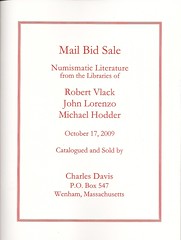 The catalogues for our October 17 sale of literature from the libraries of Bob Vlack, John Lorenzo and Michael Hodder have been mailed. During the last week we have added nearly 300 photographs of lots to our website, the link for which is a scrolling red banner at www.vcoins.com/ancient/charlesdavis. We hope you will take advantage of the feature.
The catalogues for our October 17 sale of literature from the libraries of Bob Vlack, John Lorenzo and Michael Hodder have been mailed. During the last week we have added nearly 300 photographs of lots to our website, the link for which is a scrolling red banner at www.vcoins.com/ancient/charlesdavis. We hope you will take advantage of the feature.
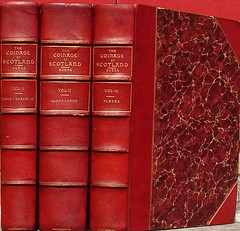

To view the photographs, see: www.vcoins.com/ancient/charlesdavis
FEATURED LOT: COL. GREEN U.S. GOLD PHOTO ARCHIVE
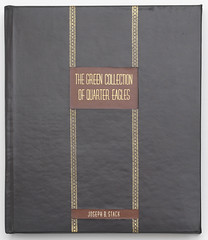 Joseph B. Stack’s personal set of this monumental photographic record, with his name stamped in gilt on an inset leather
label at the base of each front cover. Affixed to the rear pastedowns are the printed labels of B. A. MARTIN, the official
Stack’s special edition binder.
Joseph B. Stack’s personal set of this monumental photographic record, with his name stamped in gilt on an inset leather
label at the base of each front cover. Affixed to the rear pastedowns are the printed labels of B. A. MARTIN, the official
Stack’s special edition binder.
Colonel Green’s remarkable collection of United States gold coins, including many pieces from the famed Waldo Newcomer collection, remains one of the finest ever formed. The three volumes present here posthumously record his front-line collection in each of the series depicted. Taken around the time the coins were sold, in 1943 and 1944, to His Majesty The King of Egypt, these well-produced photographs continue to be extremely significant and particularly important, particularly for establishing subsequent pedigrees. A number of Colonel Green/King Farouk coins passed into the hands of John Jay Pittman, Harry W. Bass, Jr., and other major collectors.
Only a few copies of each of the above volumes were prepared and, to our knowledge, a complete set has never before come to auction. In our June 10, 2000 Harry W. Bass, Jr. Library sale, we sold examples of the half eagle and eagle volumes bound in quarter leather @ $12,000 & $11,000 respectively, the only previous appearance at auction of either volume. The quarter eagle volume included here is the first to be publicly sold.
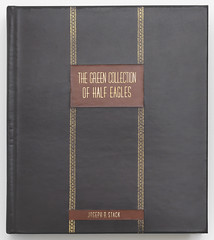
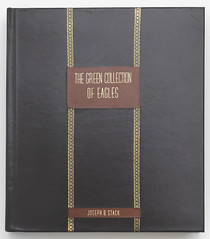
The son of financier Hetty Green—popularly known as the “Witch of Wall Street”—Colonel E. H. R. Green spent untold sums in the 1920s and 1930s on his hobbies. He vies with King Farouk as perhaps the most eccentric coin collector of the twentieth century. Both men shared an intense interest in painted women and pornography, not necessarily in that order; Green reportedly displayed a stuffed and mounted whale penis inside the entry of one of his homes.
An excellent biographical sketch of Green is featured in Special Supplement III of the Bowers and Merena August 30, 1999 catalogue of the Walter H. Childs collection, and Arthur H. Lewis’ appropriately named full-length biography, The Day They Shook the Plum Tree, perhaps best tells the remarkable story of Hetty Green and her unusual son, who, upon Hetty’s death, spent some $3,000,000 a year on yachts, coins, stamps, jewels, orchid culture, and other more libertine endeavors.
It is interesting to note that Walter Breen’s famous 1841-“O” $5 does indeed seem to be depicted in the half eagle volume, due to an unfortunate shadow effect also seen on the illustrations of several other 1840s Charlotte mint emissions. The entertaining story of this contretemps is well told on page 231 of David Aker’s October 21-23, 1997 catalogue of the John Jay Pittman collection (vide lot 4).
Thanks are due P. Scott Rubin for his assistance with this description.
NEW BOOK: WHITMAN ENCYCLOPEDIA OF U.S. PAPER MONEY
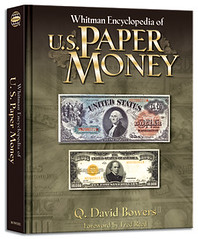 The Whitman Encyclopedia of U.S. Paper Money debuted at the first annual Whitman Coin and Collectibles Philadelphia Expo, September 23, 2009. The 900-page book by Q. David Bowers is now available online at WhitmanBooks.com, and from bookstores, hobby shops, and numismatic dealers nationwide.
The Whitman Encyclopedia of U.S. Paper Money debuted at the first annual Whitman Coin and Collectibles Philadelphia Expo, September 23, 2009. The 900-page book by Q. David Bowers is now available online at WhitmanBooks.com, and from bookstores, hobby shops, and numismatic dealers nationwide.
Drawing on the expertise of dozens of specialists from around the nation, plus Bowers's own decades-long research of the subject, the Whitman Encyclopedia of U.S. Paper Money includes historical and technical information unavailable in any other single source. The author's engaging text is supported by more than 1,600 full-color images; extensive auction data; market commentary; more than 26,000 values from a panel of experts coordinated by longtime dealer Tom Denly; multiple grades up to Unc-65; rarities; a selected bibliography; and extensive endnotes for specialized research.
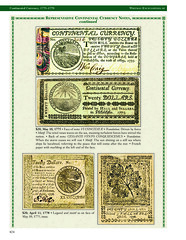 "The Whitman Encyclopedia of U.S. Paper Money has real-world advice for making wise purchases in today's market," said Whitman publisher Dennis Tucker. "But it's not just a price guide. It also gives collectors and historians a strong foundation in studying, collecting, grading, attributing, and cataloging paper currency."
"The Whitman Encyclopedia of U.S. Paper Money has real-world advice for making wise purchases in today's market," said Whitman publisher Dennis Tucker. "But it's not just a price guide. It also gives collectors and historians a strong foundation in studying, collecting, grading, attributing, and cataloging paper currency."
In addition to all federal notes, 1861 to date, from $1 to $10,000, the encyclopedia covers Continental Currency, War of 1812 Treasury notes, Fractional Currency, encased postage stamps, star notes, mules, error notes, and more.
Paper Money editor Fred Reed, who wrote the book's foreword, said, "Even collectors with years of study will find much that is new, novel, and neat in Bowers's very readable text. His teachings will make the reader a more astute purchaser of paper money."
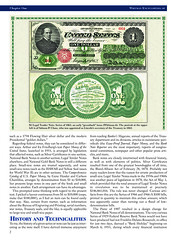
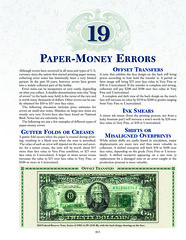
Whitman Encyclopedia of U.S. Paper Money
Q. David Bowers
Foreword by Fred Reed; valuations by Tom Denly and a panel of dealer specialists
900 pages
8.5 x 11 inches
Hardcover
$69.95 retail
THE BOOK BAZARRE
ROYAL CANADIAN NUMISMATIC ASSOCIATION HISTORY BOOK AVAILABLE
In a recent mailing to RCNA members, Executive Secretary Paul Johnson included an offer for a book on the history of the Royal Canadian Numismatic Association. Below is a copy of the announcement. -Editor
Paul notes:
This book was actually written and published in the year 2000 which was the 50th anniversary of the organization. We have some left to sell and thought that promoting it in the enclosure was a good idea.
The RCNA has done a lot to promote the hobby throughout Canada over the past 50 years. Now, RCNA members can read all about its rich, varied history and the people behind it. The hardcover book was unveiled at the 50th anniversary CNA Convention in Ottawa. It was indeed fitting that a book covering the history of the RCNA should be introduced in Ottawa, since that is where it all began.
For a number of years, Stanley Clute, RCNA Archivist, diligently worked on the project, whipping 148 page of facts together, spending hundreds upon hundreds of hours gathering up information. corresponding with many people who could contribute. For his hard work, he was honoured with a special Presidential Award at the 2000 Ottawa CNA Convention.
The book traces the history of the RCNA from events leading up to its inception in 1950 to the Golden Anniversary Year of 2000. The hard covered, nine by six inch 148 page book, is chock full of not only widely known facts, but covers much little known and/or unpublished material along with an abundance of photos, some of which have not been published before.
RCNA members can order the book from:
The Royal Canadian Numismatic Association
5694 Highway #7 East, Suite 432
Markham ON Canada L3P IB4
Cost of $18.00, which includes postage to Canadian and U.S. addresses. If 5 or more books are ordered at one time and shipped to the same address, the cost is reduced to $15.00 each.
The Royal Canadian Numismatic Association is devoted to serving those who enjoy coin collecting/numismatics by promoting fellowship, communication, education and providing advocacy and leadership for the hobby.
The book is bound in a deep blue pebbled faux-leather cover and illustrated throughout with black and white photos. Each of the five main chapters covers a decade of the society's existence. Included are recollections from key society officers including Sheldon Carroll and J. Douglas Ferguson.
From Sheldon Carroll:
I said, "Well there.. if we had a coin club maybe the word would get around and we'd get some more members." "Oh, no, no, no," they said. I found it hard to argue with the other guys who had lived in Ottawa all their lives. Here I was, an out-of-town boy. They said, "No, no, this is all the coin collectors there are," they said, "there was a policeman in Ottawa who collected coins but he moved away about ten years ago. No, there aren't any more coin collectors. This is all there are."
Finally, one or two guys sort of supported the idea and we decided to organize as the Ottawa Coin Club.
By the end of the first year the group had over 100 members. The book is full of great anecdotes like this together with reports on the society's conventions, publications, auctions and other events over the years. Appendices cover the RCNA's Educational Forums, conventions, awards and exhibits. I recommend the book to all collectors and students of the history of organized numismatics.
-Editor

REPUBLIC OF CUBA 1ST REPUBLIC 1915-1958 TYPE SET FOLDER PUBLISHED
 From the first day that I started collecting Cuban coins, the most glaring lack was the fact
that there were no coin folders to put my recently purchased coins. I searched and asked,
and looked everywhere, and was able to find an old one, busted up into pieces made by
Dansco probably about 50 years ago.
From the first day that I started collecting Cuban coins, the most glaring lack was the fact
that there were no coin folders to put my recently purchased coins. I searched and asked,
and looked everywhere, and was able to find an old one, busted up into pieces made by
Dansco probably about 50 years ago.
I continued to search and look everywhere for a Cuba type set folder, even calling Dansco to see if they had any leftover from the original printing or if they were willing to make a new batch. The answer to both was NO.
At our first meeting of the Cuban Numismatic Association, I was hoping that somebody would know or want to make a Cuba coin folder, but no one had any great interest in taking on the adventure. After a while, though, Frank Putrow, our President, made the effort of contacting a number of coin folder companies and was finally able to get a quote from one of them at about $50 a book for a minimum of 500. This was disappointing since I saw the making of a coin folder completely out of reach financially and an impossible dream.
At the January 2009 meeting, during a moment of absolute dementia, I volunteered to look into finding a less expensive way of completing this project. Although I had no idea or previous experience in doing any of this I set out to contact printing and die cut companies. Yellow pages, Google, friends, phone calls, driving from shop to shop; all dead ends. Nobody had ever done this before and they were either fearful of embarking on this project and/or simply did not want to do it.
Most of the places that I visited in the industrial area of Miami were out of a Harry Potter movie, surrounded by dilapidated warehouses, next to railroad tracks, under metro rail overpasses, or a few blocks away from the Amtrak station. Some of the doors I knocked on, looked like they hadn't been opened in weeks, with spider webs and several layers of dust on the windows.
Some of these places looked like nobody had visited them in years and the people inside looked even more surprised than I was, that they finally had a warm body come indoors. As much as they wanted the business, they had no idea of what my project was, nor did they feel capable of undertaking it.
After visiting a large number of print shops and die cut companies, and showing them the scope of the work, I had almost given up; however, as if by divine guidance, I visited what I thought would be my last try at convincing somebody to do this for me. I dropped in on a shop next to the Amtrak station in Hialeah, the place looked abandoned on the outside, but a busy, albeit, small print shop inside.
I explained my project for the hundredth time, and although they were not receptive to being able to do the job, they said they used this great Cuban owned print and die company for all their die cut work. She was very kind, even calling their salesman, George Acosta, and setting up an appointment with him the very same day.
"If anybody can do this, Fastkit can" she told me in a very confident voice, trying to reassure this desperate looking face, on the verge of giving up. She saw my desperation, my frustration, my this is my last try look, so when making the call, maybe not wanting to be responsible for my throwing myself under a passing train out of frustration, she may have even stretched the nature of our relationship, just to make sure I was able to see George at Fastkit that day. That meeting turned out to be one of my greatest days as a numismatist.
As I explained what the project entailed, (for the 20th time in a week), I was surprised with the glow in his eyes, somebody actually took great interest in what we were trying to do. He called Jose Fernandez, one of the owners, into the meeting and his eyes also glowed in happiness, his father would love to have a Cuban type set book like that, with his own coins.
He then called his father into the meeting, and as his father walked in, Jose is telling me "I don't care how much money you have, I don't care how much this is going to cost, and we are going to do this project and will figure out later how we are going to pay for it". They asked me to come back for a second meeting with David Barjun, the art director, so that we could start the art work process. Needless to say, I flew home to tell Dora and Frank.
Four months after my initial contact, 20 or 25 meetings later and the greatest cooperation I have ever received from a company who is trying to sell something to a customer on a job where they are going to lose more money than they planned on, I was able to hold in my hands this beautiful Cuba type set coin folder thanks to the efforts of many people.
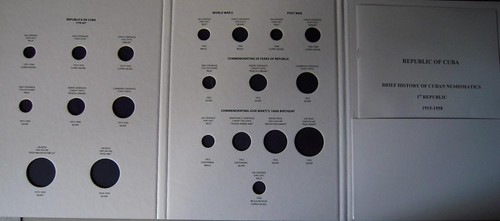
We finally did it, the books are done! Come and get them while they're hot!
What a great story, and one with a happy ending! Congratulations to Jesus Inguanzo and the Cuban Numismatic Association. -Editor
David Lange adds:
I bought one on eBay last week. They did a nice job overall, but the spine is actually larger than necessary, which prevents the pages from lying flat when folded. I suppose this would correct itself with regular use but, of course, I don't plan to use mine!
To visit the Cuban Numismatic Association web site, see: www.cubanumis.com
CNA President (and new E-Sylum subscriber) Frank Putrow adds:
Our web site is under construction and our webmaster is not well, so we will not have the site updated for a few weeks. As a result the current newsletter or the book information will not be on line. In the meantime, I can be contacted at Fxputrow@aol.com, or 727-531-7337.
CATALOGUES: WHAT TO LEAVE IN, WHAT TO LEAVE OUT
Michael E. Marotta writes:
"… what to leave in; what to leave out…" – Bob Seeger
Joseph Boling's views on the Krause Paper Money CD, (E-Sylum Volume 12, Number 39, September 27, 2009) raise basic questions about what "money" is.
An easy focus on nation-states is myopic. The Krause catalogs list the paper money of the Bank of England, the Bank of Greece, and the Federal Reserve Banks of the USA. Those are all private institutions. Back in 2000, when the Royal Canadian Mint introduced the two-dollar "twonie" coin, some banks wanted to buy them with one-dollar "loonies." The RCM refused. Only the notes of the Banque du Canada are legal tender. Coins are a convenience. In Greece, before the Euro, the situation was reversed: as issues of the government, coins were legal tender while the notes of the Bank of Greece were a convenience.
Consider that some Hong Kong banks, several Scottish banks, as well as the East Caribbean, East African and Central African currency unions are little more than checking accounts. Their reserves are in the currency of another agency, just as you back your checking account with Federal Reserve Notes.
Having worked on the Traverse City "Bay Bucks" project (www.baybucks.org), I am fully aware of the fact that not every issuer of money can be catalogued. On the other hand, by volume and continuity, Disney Dollars eclipse the money of many small nations. A numismatic cataloguer makes choices, as does every author and editor. I suggest that by the end of this century, numismatic catalogues will consider history, volume and collectability in preference to political (versus commercial) status.
To read the earlier E-Sylum article, see: COMMENTS ON THE RED BOOK OF U.S. COINS - PROFESSIONAL EDITION (www.coinbooks.org/esylum_v12n39a08.html)
NEW YORK TIMES LIBRARIAN AWARD NOMINATIONS
Rick Witschonke writes:
Some of us at the American Numismatic Society are submitting nominations for a New York Times Librarian Award for Elizabeth Hahn, ANS Librarian. E-Sylum readers who have had a positive experience with Elizabeth might want to do so as well.
The nomination form is at: www.ilovelibraries.org/lovemylibrarian/public.cfm
It only takes a few minutes to complete, but the deadline is October 9. Elizabeth's details are:
Elizabeth Hahn, M.A., M.S.L.I.S.
Librarian - American Numismatic Society
75 Varick Street, 11th Floor
New York, NY 10013
Tel: (212) 571-4470, ext. 170
hahn@numismatics.org
http://www.numismatics.org/Library/Library
AMERICAN NUMISMATIC SOCIETY ARCHIVAL COLLECTIONS
I've recently added a new page to the ANS site. Located at http://www.numismatics.org/Archives/Collections the new page provides an overview of the 80+ archival collections currently housed at the ANS.
I should note that only a few of these collections have ever been cataloged, so this is the first time users will be able to see what archival collections the ANS has gathered these past 150+ years. I think visitors may be surprised at the breadth of subject matter. Areas of strength include early American coinage.
The new site provides a listing of all the collections along with brief descriptions of most. I hope to have descriptions for the rest shortly.
To vist the ANS Archive Collections page, see: www.numismatics.org/Archives/Collections
Title: John W. Adams collection, 1855-1972
Extant: 1 box (1 cu. ft.)
Description: This collection contains correspondence, catalogs, notes printed matter and photographs primarily from the 1940s related to U.S. large cents. It includes correspondence by George Clapp, Homer Downing, Walter Breen, Henry Hines, Max Mehl, and Howard Newcomb, among others.
Title: Etienne-Jean-Baptiste Cartier papers, 1830-1851
Extant: 1 box (.3 cu. ft.)
Description: These papers consist of about 280 letters written by Cartier, the originator of Revue Numismatique, to the co-founder of the Revue Numismatique, Jean-Francois de Paule-Louis de La Saussaye.
Title: Adam Pietz papers
Extent: 1 box (.3 cu. ft.)
Description: The papers contain artwork, sketches and assorted other documents related to Adam Pietz, the Assistant Chief Engraver to the U.S. Mint in Philadelphia.
Title: John Reilly, Jr. papers, ca. 1900-1931
Extant: 4 boxes (4 cu. ft.)
Description: Reilly's papers contain correspondence and photographs related to Reilly's acquisition of Far Eastern coins, in particular the Henry Ramsden collection.
Title: Farran Zerbe papers, 1919-1942
Extant: 1 box (.3 cu. ft.)
Description: The papers include correspondence between Zerbe and other prominent collectors primarily regarding "Bryan Money." Correspondents include: Howland Wood, Julius Guttag, Henry Chapman, and M.H. Bolender.
THE BOOK BAZARRE
DR. NORMAN E. BORLAUG'S MEDALS ON DISPLAY
While his name isn't a household word, it ought to be. Borlaug's groundbreaking research into increasing crop yields spawned an agricultural revolution that saved millions from hunger. If real life were a science fiction movie with the world in danger of imminent starvation, Borlaug would be the mousy scientist in a lab coat whose brainstorm saves the planet.
He is the Rita Moreno of achievement awards, and deservedly so. But when he passed away in September his obituary ran almost unnoticed beneath a blizzard of B-list celebrity deaths. But on October 6th visitors to his memorial service at Texas A&M University will be treated to an exhibit of his astounding medal collection. -Editor
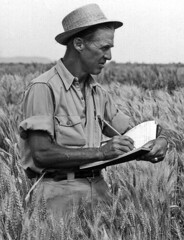
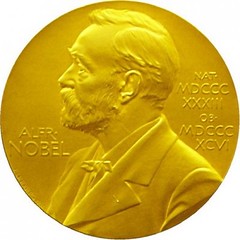
People who attend memorial services for Dr. Norman E. Borlaug Oct. 6 can get a view of a rare collection of medals. Borlaug was one of only five people ever to have won the Nobel Peace Prize, the Presidential Medal of Freedom and the Congressional Gold Medal. When he was granted the congressional medal in 2007, he joined Martin Luther King Jr., Mother Teresa, Nelson Mandela and Elie Wiesel as winners of all three prestigious honors.
Those three medals, along with Mexico's Order of the Aztec Eagle, will be on display in Texas A&M University's Rudder Tower on Tuesday, Oct. 6 from 9:45 a.m.-1:30 p.m. The memorial service will begin at 11 a.m. It is free and open to the public. A reception will follow from 12:30-1:30 p.m. in the Rudder Tower Exhibit Room.
Also available for public viewing will be a new collection of video segments of Borlaug recalling various highlights of his career and expressing his opinion of what battles remain in the fight against global hunger. The collection will air repeatedly throughout Oct. 5-6 at the Rudder Tower Visitor Center. It is also free and open to the public.
To read the complete article, see: memorial services for Dr. Norman E. Borlaug (media-newswire.com/release_1101013.html)
MORE ON THE KYOTO ECONOMIC REVIEW WEBSITE
Regarding last week's Featured Web Site, Joe Boling writes:
Bruce Smith's reference to the Kyoto Economic Review website said it would have articles 1926-present. I found them only until 1992. He also said they are in English and German - I tried to open one in 1926, and had to download the Japanese fonts from Adobe in order to read it - ten megabytes worth of download. But - yes- the article is in English. Apparently accessing anything on the site requires Japanese because that's the native language of the site.
Another article does have some Japanese text embedded in it but since it's all .pdf (thus an image, not true text), it should not make any difference whether the Japanese fonts are available. It's not surprising that there is a five-year gap in publication, from 1945-50, but it IS a surprise that all through the war years the journal continued to be published in an English edition.
To access the web site, see: www.econ.kyoto-u.ac.jp/review/
LAST WORD ON THE 1959 HAWAII GOLD STATEHOOD MEDAL
Bob Rhue writes:
 I would like to publicly thank Dick Johnson for the time and patience he showed me in answering my follow up questions to his posting regarding the mintage of the Gold Hawaii Statehood Medals. I was a bit confused by the last sentence of his response, and he very kindly agreed to speak with me on the phone.
I would like to publicly thank Dick Johnson for the time and patience he showed me in answering my follow up questions to his posting regarding the mintage of the Gold Hawaii Statehood Medals. I was a bit confused by the last sentence of his response, and he very kindly agreed to speak with me on the phone.
To clarify my confusion he stated unequivocally that although he is not the source for the quantity struck data for Medallic Art Company items in general, he does consider his quantity struck for Hawaiian Gold Statehood Medals (quantity 58), as well as the medals on all twenty items for which he had contemporaneous records on "green cards" to be reliably accurate. For Dick's contribution to the resolution of this longstanding numismatic question of the mintage records I am forever grateful.
Dick stated to me that although he did not have similar "green card" contemporaneous records for the Alaska gold, silver and bronze statehood medals, he assumed that roughly the same number of Alaska gold medals were struck as those struck for Hawaii.
Jan Monroe adds:
The additional 154 silver unnumbered silver medals were ordered by Governor James K. Kealoha to give out as gifts from his office. Originally only 2,500 silver numbered medals were struck but citizens of Hawaii complained and 500 more numbered silver medals were struck.
To read the earlier E-Sylum article, see: MORE ON THE 1959 HAWAII GOLD STATEHOOD MEDAL (http://www.coinbooks.org/esylum_v12n39a16.html)
MORE ON COINS PICTURED ON BANKNOTES
Neil Shafer writes:
Thinking of coins on notes, the Greek series has a good many examples of such issues. Some are well engraved, others (as in the German occupation series) are not so nicely done but still show lots of ancient coins. Also the India series has a large group, mostly the 1 rupee but possibly others including Hyderabad.
Then there are the National Gold Bank issues of California with their backs full of gold coins. The most interesting, or should I say controversial, is the $5 Silver Certificate that shows images of five Morgan dollar reverses overlapped in such a way that none can show the full "In God We Trust" motto. It's all there but not on a single piece. So when the question comes up, when was the motto added to paper money, is the answer 1886 or 1963?
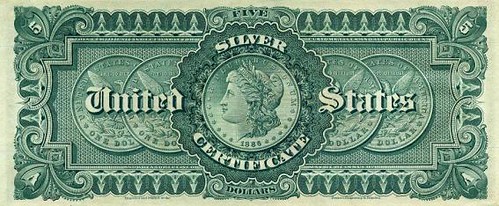
Any others escape me at the moment but I'm sure a good many exist, and a great display could be assembled showing this characteristic.
To read an earlier E-Sylum article, see: MORE ON COINS PICTURED ON COINS (www.coinbooks.org/esylum_v12n38a19.html)
NUMISMATICS AND SHERLOCK HOLMES
Back in 2002 we had several articles about numismatics in Sherlock Holmes stories. I came across a book on the topic for sale this week on AbeBooks and thought I'd mention it. Here's the listing:
SIMPSON'S SHERLOCKIAN STUDIES. Volume 7. 1959. Numismatics in the Canon. Part III: Small Titles and Orders; Simpson, A. Carson
Bob Van Ryzin was the first to clue us in on the existence of this work. He wrote:
"In reference to Bob Fritsch's comment in V.5 No. 28 July 7, 2002, The E-Sylum, concerning detailed references to Holmes and numismatics, I can offer the following:
I know of at least one extensive study of numismatics in the Canon. It appears in Simpson's Sherlockian Studies by A. Carson Simpson, privately printed between 1953 and 1961 in nine volumes. In 1982, these volumes were compiled into book form by Magico Magazine, with an introduction by Isaac Asimov. If memory serves me, original sets of the Simpson volumes were scarce even back in the 1980s. The book I purchased was issued in an edition of 100 hardcover copies signed by Asimov and a trade version.
Volumes 5, 6, and 7 feature a three-part series on the coins, paper money, medals and orders in the Canon. Each of these "parts" runs in the range of 40 pages, with detailed descriptions of the various numismatic items that may have been encountered as well as Conical references. There's also a volume titled "Conical Philately."
To read the complete for-sale entry, see: http://www.abebooks.com/servlet/ListingDetails?bi=1411873004&cm_ven=nl&cm_cat=trg&cm_pla=want&cm_ite=viewbook
To read the earlier E-Sylum articles, see:
NUMISMATIC HOLMES
(www.coinbooks.org/esylum_v05n26a07.html)
HOLMES IN NUMISMATICS
(www.coinbooks.org/esylum_v05n27a08.html)
MORE SHERLOCKIANA
(www.coinbooks.org/esylum_v05n28a11.html)
THE BOOK BAZARRE
SUBSCRIBER PROFILE: JOHN SALYER
John Salyer began collecting coins as a sixth-grader, in Fort Worth. After graduating from the University of Texas he remained in Austin, where he worked for several different state and federal government agencies.
Eventually relocating to Dallas, John was employed as a numismatist and coin cataloger by Heritage Auction Galleries for seven years. John's current collecting interests include Conder tokens, U.S. and Canadian Fractional Currency, and numismatic reference works of all sorts.
He offers a variety of services to coin collectors through his upcoming website: cigarboxcoins.com. John can be contacted at: jasalyerjr@yahoo.com.
NOTES FROM ALAN MEGHRIG: INDEX ACRONYM AND SELF PUBLISHING
Alan Meghrig writes:
In his piece proposing an index of articles of numismatic interest in non-numismtic publications, Dick Johnson wrote: "What to name it? I wanted a memorable acronym. If it could be a companion to Harry Bass's NIP I immediately thought of TUCK. NIP and TUCK would cover both. But no such luck for tuck. I could not come up with appropriate words for a TUCK acronym."
Here's my suggestion: Totally Unknown Coin Knowledge
And as for why the Getz book did not go to a self publisher like Blurb:
- Very little selection of paper… the Getz is on acid-free, smooth which reproduces all the detail you can generate.
- No selection for image resolution… The Getz book printer has a maximum resolution 2400 dpi. If the image we had was high resolution, we printed it that way.
I am sure your readers can understand why companies sell what they do --- PROFIT and how that is generated.
NOTES FROM GINGER RAPSUS: ENGRAVING LOVE TOKENS, RCR INDEX
Ginger Rapsus writes:
Great issue! A little bit of everything, on so many different topics. Interesting piece on engraving bank notes. Is there anything available on engraving coins, not so much the coin designs, but such things as love tokens? And speaking of indexes, isn't there an index for the Rare Coin Review? I remember seeing this offered a few years ago.
I believe the Money Tree compiled and sold an index to Rare Coin Review many years ago. I don't have my copy handy - can anyone confirm this? Thanks. -Editor
COMMENTS ON THE 2009 WHITMAN PHILADELPHIA SHOW
Russ Sears writes:
Saturday I managed to coordinate a bus trip to the Whitman show in Philadelphia. It is too far for me to drive, see the show and then drive back.
Arriving at the show at around 11 o'clock, I found a well organized show with some nice exhibits and talks. But, there were too many tables empty, without dealers. At 12:50 I came upon the table of a dealer who I thought would have some of the Continental notes (Baltimore February 1777) I went to buy. He was packing and had to get out of there for an event at home and couldn't show me what was sitting in his case.
I was very unhappy to have spent the money and time to go about a hundred miles to a show which was more than disappointing. Except for the forthcoming A. N. A. convention in 2012 in Philadelphia, that was my last Philadelphia show. It was one of if not my worst coin shows in almost 40 years in numismatics. And, I don't necessarily measure shows by how much I buy. If coin dealers complain about their business level at shows, one of them at this show likely lost $300 to $1,000 in sales.
Alan V. Weinberg writes:
While it is true that many dealers were packing up mid-afternoon Saturday while the public was still heavy in the aisles, the overall impression I received from strolling the aisles Wednesday-Saturday was satisfaction with the show and all its amenities (carpeting, lighting, nearby hotels and restaurants and the nearby wonderful Reading Terminal "indoor farmer's market" with its hundreds of ethnic eating booths, together with a heavy neighborhood uniformed police presence.
While I did acquire three superb related pre-1900 American silver award medals in a "hotel buy", the highlight for me was the superbly catalogued Stack's Americana auction which had numerous what I term "opportunity only" items - items that appear so rarely that all the money and contacts in the world cannot find a duplicate. You just have to wait for the "opportunity".
With the fairly recent dispersal of the Ford and Norweb material and some material coming out of museums and historical societies (like the Maryland Historical Society November 2009 Stack's offerings) due to the economic downturn, these opportunities are there. And they seem to bring out all the "oldtime collectors" who otherwise rarely attend shows with their slabs as far as you can see.
One of the premier highlights of the show was the Chinese counterfeit session and the attendant two-case display of the best (so far) American counterfeits. The quality was both jaw-dropping and scary. The session I attended was heavily attended & highly educational and it was stressed that the fakes passed around at the talk are months behind the sophistication recently seen and that the future holds really deceptive technological advances. One of the main concerns expressed was the complete indifference of the US Customs Office in permitting these superb Chinese fakes to enter the country. They just pass them on through - even fakes of modern circulating coinage in "error" form. The speaker at these sessions (so heavily attended that it seems they expanded the sessions to other days) Dr. Greg DuBay actually has visited and befriended these Chinese counterfeiters with the purpose of expanding American collector knowledge about what's to come.
The show atmosphere was upbeat, attendance of collectors seemingly quite heavy and the show was a much improved show overall relative to the recent Los Angeles ANA and Long Beach shows. I really liked this area of Philadelphia and thought it ideal for a future ANA.
The Whitman Expo man-in-charge David Crenshaw let it be known that the 2010 Philadelphia Expo would be held Labor Day weekend. Whoa! All sorts of protests developed and the last I heard, Whitman responded and promptly re-scheduled the show four weeks later. Bravo!
According to the Whitman web site,
ANS COAC LECTURE: AUGUSTUS SAINT-GAUDENS AND CHARLES BARBER
On October 10, 2009, award-winning author Michael Moran will present "Augustus Saint-Gaudens and Charles Barber: Unbounded Egos—Unbounded Conflict," at the American Numismatic Society's Stack Family Coinage of the Americas Conference. The conference takes place at ANS headquarters in New York City.
Moran is the author of Striking Change: The Great Artistic Collaboration of Theodore Roosevelt and Augustus Saint-Gaudens (Whitman Publishing, 2008), which won a 2008 Extraordinary Merit award from the Numismatic Literary Guild.
"Numismatists in this country universally hold Augustus Saint-Gaudens in reverence for his magnificent twenty-dollar gold piece design, the best to ever come from the United States Mint," said Moran. "At the same time they are quick to condemn Charles Barber, the mint engraver, for his seemingly obstructionist attitude in refining Saint-Gaudens's design to a coinable relief."
Drawing from his book, Moran will discuss in detail this conflict between two men of strong egos, explaining its origin in the early 1890s. He will dispel some myths surrounding Saint-Gaudens's award medal for the Chicago World's Fair of 1893, when conflict between the two men turned to outright animosity, spilling over into the New York newspapers. He will also trace the jabs that the two men threw at each other leading up to Theodore Roosevelt's challenge to Saint-Gaudens to redesign the nation's coinage.
"Saint-Gaudens's strategy to keep the engraving of his designs out of Barber's hands collapsed during a luncheon at Oyster Bay, the summer White House, in September 1906," said Moran. "American coin collectors recognize the end result as the Saint-Gaudens twenty-dollar gold piece." Moran contends that Barber's role in making this design suitable for general coinage has been maligned and underappreciated.
"I present the facts in this talk to allow the listener to reach his or her own conclusions," said Moran. "Did Saint-Gaudens bear some of the blame for the problems encountered with his twenty-dollar gold piece design? Was Charles Barber at fault for creating an uncommunicative atmosphere during the process? Is the truth somewhere in the middle?"
Moran's lecture is one of several planned for the symposium, scheduled for 10 a.m. to 5 p.m., October 10. An optional guided tour of the "Augustus Saint-Gaudens in the Metropolitan Museum of Art" exhibition starts at 6 p.m.
The cost of the 2009 COAC symposium and lunch is $125 for ANS members and $160 for nonmembers.
Registration and prepayment are required, by credit, PayPal, or check. Checks should be made payable to American Numismatic Society and can be mailed to Megan Fenselau, Membership Office, American Numismatic Society, 75 Varick Street, Floor 11, New York NY 10013. Fenselau can be contacted by phone at (212) 571-4470, ext. 117, or by email at membership@numismatics.org.
HOMETOWN NEWSPAPER PROFILES ANA FOUNDER GEORGE HEATH
 Dr. George F. Heath, who practiced medicine in Monroe from 1884 until he died in 1908, founded the American Numismatic Association.
Dr. George F. Heath, who practiced medicine in Monroe from 1884 until he died in 1908, founded the American Numismatic Association.
Dr. Heath enjoyed collecting coins as a way to gain knowledge about world history, according to the ANA Web site, www.money.org. But because he was isolated in a small town, he reached out to other numismatists by pushing a four-page leaflet, "The Numismatist," in 1888.
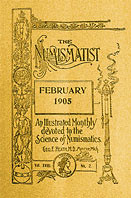 The leaflet’s circulation grew, so in 1891, Dr. Heath proposed starting the American Numismatic Association. "There is nothing like the alliance of kindred pursuits to stimulate growth and interest," he wrote.
The leaflet’s circulation grew, so in 1891, Dr. Heath proposed starting the American Numismatic Association. "There is nothing like the alliance of kindred pursuits to stimulate growth and interest," he wrote.
The ANA was founded during a meeting in October, 1891, in Chicago with 61 charter members.
The ANA now is the largest nonprofit numismatic organization of its kind in the world, the group says.
The ANA’s headquarters in Colorado Springs, Colo., houses the largest numismatic library in the world along with a museum.
Besides being a physician, Dr. Heath served four terms as mayor of Monroe and was the first president of the Monroe County Medical Society.
He died unexpectedly on June 16, 1908, and is buried at Woodland Cemetery.
To read the complete article, see: Monroe doctor a giant in coin world (www.monroenews.com/apps/pbcs.dll/article?AID=/20090920/ARTS/709209990)
CLASSROOM SMART BOARD GREAT FOR DISPLAYING COINS
Dick Johnson writes:
I liked this article for the use of -- not only coins in the classroom -- but also how technology in improving learning visualization in education.
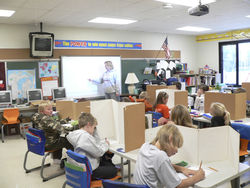 According to Mid-Pen Technology instructor Tammy Hereau, a "smart board" is a white interactive board which is replacing slate chalkboards and two dimensional pull down maps.
According to Mid-Pen Technology instructor Tammy Hereau, a "smart board" is a white interactive board which is replacing slate chalkboards and two dimensional pull down maps.
"Teachers using the smart board are able to connect and interact with a computer. A smart board replaces the former overhead projectors most of us remember from grade school," said Hereau.
Hereau said use of the smart board technology in the classrooms allows for the students to view and listen to streaming video on the Internet as a learning aid.
A document camera used as part of the technology is so advanced, noted Hereau, that a teacher can scan in on a coin to show what the naked eye cannot see.
"The document camera can act as a microscope, allowing a teacher to zoom in on the back of a penny so close, the students can see President Lincoln sitting on his chair in the center of the Lincoln Memorial," she said.
MYTH: ALCOHOLICS ANONYMOUS TOKENS REDEEMABLE FOR DRINKS
Every now and then the mythbusting web sites have an article with a numismatic connection. In an item published this week on Snopes.com, someone asks,
The site's editors conclude this tale is merely a LEGEND with no basis in fact (as if something that crazy could ever be true).
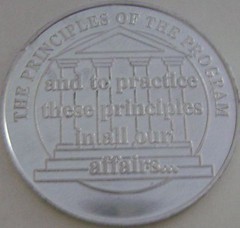 Addiction is not something that is fought once; it is a foe that needs be wrestled with constantly. It is for this reason that many who have successfully availed themselves of the Alcoholics Anonymous (AA) program choose to carry in their pockets small tokens that serve to constantly remind them of the importance of their sobriety, lest a fleeting instance of complacency prompt them to forget the nature of the battle they must wage each and every day.
Addiction is not something that is fought once; it is a foe that needs be wrestled with constantly. It is for this reason that many who have successfully availed themselves of the Alcoholics Anonymous (AA) program choose to carry in their pockets small tokens that serve to constantly remind them of the importance of their sobriety, lest a fleeting instance of complacency prompt them to forget the nature of the battle they must wage each and every day.
The most popular of such mementos is the sobriety medallion or chip. One of the earliest AA members carried such a token (
While each group within AA operates by its own rules, it has become somewhat the norm for a member's home group to present a successful newcomer with a medallion on the first anniversary of his last drink. Said disc will likely be engraved with the date of the member's sobriety and either a generic statement (e.g., "The day my new life began") or the member's favorite of the standard AA slogans, one that he particularly drew strength from in his first year.
Additionally, many groups make it their practice to hand out poker chips or marbles at the one-week, one-, three-, six- and nine-month milestones. These less formal tokens of recognition, while of no appreciable monetary value themselves, are treasured nonetheless because they are peer group recognitions of the struggle the individual is engaged in.
For someone fighting day by day to maintain his newfound sobriety in the face of all life has to throw at him, they serve as tangible reminders that others (particularly those who have also weathered these storms) have noted the newcomer's progress and are cheering him on. They also serve as tangible reminders of his promises to himself.
The belief that either AA sobriety anniversary medallions or their ersatz
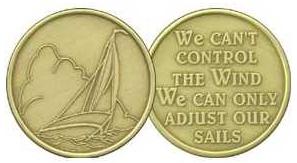
To read the complete article, see: Testing One's Medal (http://www.snopes.com/medical/potables/medallion.asp)
NEW RUSSIAN KALUGA STATE 10 RUBLE COIN
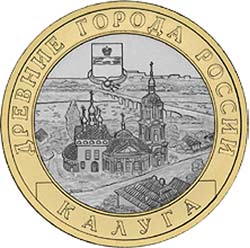
NEW SILVER CRANE COIN FROR WIRTLANDS VIRTUAL NATION
Two months after successful launch of Wirtland's gold coin, Wirtland now introduces its first silver coin, the "Silver Crane". The new "Silver Crane" weighs 1 troy ounce (31.1 grams) and consists of .999 pure silver, its diameter is 39 mm.
The coin's denomination is 2 International Currency Units (ICU). The "Silver Crane" can be purchased online for 38 US dollars from Wirtland's official mint.
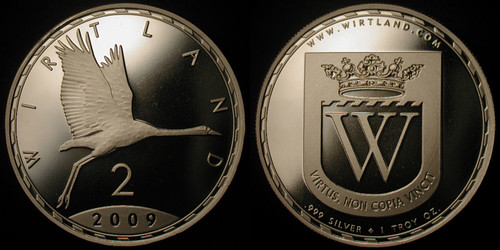
The design of new silver coin is similar to 1/10 ounce "Gold Crane" which was considered to be the world's first physical gold coin issued by a virtual country, and called a "work of art" by experts. The silver coin, which is much larger in size, features the same image of migratory crane, symbolizing that virtual country transcends lands and borders.
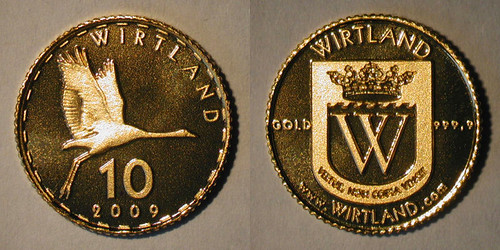
To read the complete article, see:
After "Gold Crane", Wirtland introduces new coin "Silver Crane"
(wirtland.blogspot.com/2009/09/after-gold-crane-
wirtland-intoduces-new.html)
To read an earlier E-Sylum article on Daniel Carr, see: NEW "HARD TIMES" TOKENS FROM COIN DESIGNER DANIEL CARR (www.coinbooks.org/esylum_v12n02a17.html)
COINAGE OF ALANUS I, KING OF BERMANIA
I have in previous Around the World columns made comments alluding to Bermania existing only in the mind of Fairfield, Connecticut coin dealer Allen G. Berman. I have also made remarks that numismatic emissions of Bermania are fantasy issues. Well, now it's time for Bermania to strike back! Alanus I, King of Bermania, submitted a clarification statement August 18 from the Royal Bermanian Embassy in Fairfield. Readers familiar with medieval European financial history will particularly appreciate his opening remarks.
According to the statement, "Bermania's coinage is a fully redeemable base silver based coinage. Bermania is the last country to follow the Edict of Pitres of Charles the Bald (864AD). One denarius argentum is still redeemable for 0.05247588 troy ounces of pure silver. As king, it is our obligation to honor this for the full duration of our life. Thus the Royal Wedding coin of 1998, with a face value of 5 denari plumbi (= 1 denarius argentum) will always be redeemed for roughly 1/20 of an ounce of silver. We have personally spent Bermanian coins and have been well pleased by the tendency of merchants, or at least those who accept them, to give a very favorable rate.
"It must be admitted that the recently rediscovered horse cart tokens can no longer be used, but that should come as no surprise. They were not issued by the royal government in the first place. They were issued by Schmuel the Carter to honor his horse's bat mitzvah in 1940. They were good for a ride anywhere in Bermania in their day. But no horse lives forever and who would expect a horse born in 1927 to be pulling carts if she were alive today anyway?"
I haven't been able to find Bermania on a map, nor can I find the royal family listed in the Almanach de Goethe. According to the statement from Bermania, "It is not the easiest country to get to. All the maps to it are erased on a daily basis by the Bermanian Society of Secret Cartographers for reasons of national security. But if you re destined to pay us a visit we know you will find a way."
In a separate correspondence Allen Berman added, "While it is quite possible that most of the coins issued by micro-nations are 'made by somebody simply to make a profit for themselves' as you said in your article, the coins of Bermania, the first example you cite do not fit into this category. Bermania was created as an inside joke in the 1970s but soon took on a life of its own.
Initially a method of honoring my friends through grants of arms and titles, it has become internationally recognized as a means of making the world smile via heraldry, parade appearances, acts of charity, wearing funny costumes, and via the country's quirky history delivered in the form of stand-up routines at [the] annual royal court, as well as at the New York International Numismatic Convention and Chicago International Coin Fair."
To read the complete article, see: And Now, a Word from Alanus I, King of Bermania (www.numismaster.com/ta/numis/Article.jsp?ad=article&ArticleId=7832)
GOOGLE'S COPYRIGHT CASE
Defoe's metaphor nicely points toward copyright's public ends: both books and brats grow up; their relationship to those who bore them changes over time. Like a farmer's children, books must help their author make hay until they come of age, whereupon they are free to leave home and participate in the larger community.
This history has been on my mind recently because it is about to reappear in a courtroom where Judge Denny Chin of the Federal District Court for the Southern District of New York will very likely hold a hearing later this fall on the proposed settlement of the lawsuit brought by authors and publishers against Google, after Google made digital copies of millions of in-copyright books. The settlement is currently being revised in the wake of objections raised by the Department of Justice and other parties. But whatever form it takes, before he approves it Judge Chin will have to deal with the ghost of Defoe's parental metaphor, come now to pose a riddle Defoe never had to consider: What shall we do with the orphans?
Orphan works are all those Brats whose copyrights are still active but whose parents cannot be found. There are millions of them out there, and they are gumming up the world of publishing. Suppose a publisher wants to print an anthology of 1930s magazine fiction. Copyright now lasts so long (a century in many cases) that the publisher must assume that there are rights holders for all those stories. Suppose that half the owners can't be found. What should the publisher do? Its lawyers will advise abandoning the anthology: statutory damages for copyright infringement now stand between $750 and $150,000 per instance.
Of more than seven million works scanned by Google so far, four to five million appear to be orphaned. If Judge Chin approves the settlement in something close to its current form, the authors and publishers will let Google commercialize these works — sell them, display them online with ads, charge libraries for their use, and more. A portion of the money thus earned will go to Google outright; the rest will go to a new Book Rights Registry, where it will regularly be set aside for five years waiting for absent owners to claim it. At the end of each five-year period, all unclaimed funds will be distributed to the authors and publishers whose works the registry represents.
This is a smart way to untangle the orphan works mess, but it has some serious problems...
To read the complete article, see: Advantage Google (www.nytimes.com/2009/10/04/books/review/Hyde-t.html)
MYSTERIOUS LEDGER SIX NINE FOUR: END OF THE SILVER DOLLAR BAR
Recall a few editions past the story about Silver Dollar Smith and his Essex Street Saloon. Here is the rest of the story from Ledger 694.
TO MAKE WAY FOR A NEW WAREHOUSE
New York, March 15 – The old saloon of Silver Dollar Smith, which he made famous when he paved the floor with silver dollars to excite the wonder of the wealthy and the envy of the poor who patronized his bar, is shortly to disappear. It was sold yesterday by its owner, Alfred S. Engel, son of Martin Engel to Roth & Berkowitz of 409 Grand Street. They are going to tear it down and erect on the spot a furniture warehouse. Business in the place has not been good since the death of Silver Dollar Smith.
Although it is opposite the Essex Street Market Police Court, trade had drifted away, for there were no longer the silver dollars and the five-dollar gold pieces for the thirsty to walk upon. In the palmy days of Smith the saloon was the haunt of East Side politicians and one of the show places of the city. It was reported that the wealth sunk in the floor amounted $1000. There was a five-dollar gold piece in the center of each square of marble pavement on the floor and a silver dollar in each corner.
Smith kept a close watch on the dollars as long as he lived and nobody ever got away with one. After Smith died his widow needed money and took the dollars from the floor and the glory from the place. The money had been worn on one side by countless feet and was no good for currency. Mrs. Smith took it to the mint and disposed of it, according to one report, for half the amount it represented before it went to pave the floor. She ran the place for a year and then gave it up. John H. Martin has been running it for the last five years.
To read the earlier E-Sylum article, see: MYSTERIOUS LEDGER SIX NINE FOUR: SILVER DOLLAR SMITH (http://www.coinbooks.org/esylum_v12n35a10.html)
MYSTERIOUS LEDGER SIX NINE FOUR: NICKEL SHORTS
OLD-FASHIONED NICKEL, WITH FIGURE "5" ON OBVERSE
OR "HEAD" SIDE DECIDES MINT OFFICIAL
Washington, June 22 – An old fashioned nickel gave Sec Shaw a new financial problem to decide today. It accompanied the following letter, which was addressed to Uncle Sam, Washington, D.C.
"Please find in close .05 ct for which I want you to tell me which side of the nickel is head and what is tails. Use nickel for postage in return. The nickel was one of the old-style with a large figure 5 on one side and a shield and the date on the other. Ordinarily the date appears on the "head" of all coins, but it struck Mr. Shaw that it was different with this one. He wanted to be fair, so he called in of his assistants but they could give him no advice. Finally the coin and letter were sent to the director of the mint, who disposed of the question with a long and formal letter to the anxious inquirer in which it was stated that the government knows neither "heads" nor "tails," but that each coin has an obverse and reverse side. In the coin in question, the figure 5 showed the obverse side, or the "head" in popular parlance. The reply was sent in a franked envelope and the government pocketed the nickel.
New York. May 11 – Charles Kaplan of 402 Osborne Street, East New York, owes his life to a five-cent piece. He was walking along Livonia Avenue early yesterday morning when he saw two men fighting. He separated the combatants when one of them pulled a revolver and shot point blank at the peace-maker. Kaplan put his hand in a waistcoat pocket and found a flattened piece of lead and a bent nickel.
BOY'S POCKET PIECE RECALLS CURIOUS FINANCIAL OPERATIONS
The man who had just bought a cigar glanced at his change, and picked out a nickel which bore evidences of having been gilded. "That's funny," he observed, "wonder why anybody should ever bother to gild a nickel." "Probably some youngster did it to provide himself with a pocket piece," said the dealer, "Just as it used to be a habit of boys to silver a penny by rubbing mercury over it. It was a laborious occupation, but it made a rare pocket piece when I was a boy, and many a fine marble was swapped for one of them.
"The gilded nickel, though, reminds me of the epidemic of the sort that came a little over 20 years ago [1883] when the present style of coin was first adopted. Perhaps you remember that a few coins were issued without the word "cents" under the "V." It occurred to some happy soul that the "V" might as well apply to dollars as to cents, and that covered with gilt the coin ought to pass for a half-eagle. The result was that thousands of nickels were gilded, and it seemed as if half of those in circulation were either a bright yellow or gave indications of having been.
"Occasionally now you run across a nickel like that one you have there, with traces of yellow on it, and I never see one without thinking of the hours I put in as a boy trying to turn nickels into what I thought might pass for five-dollar gold pieces."
THE INTRICATE ART OF THE BANKNOTE
Early banknotes had very little on them – usually just some indication as to what the value of the note was – but gradually over time, and as the ability to print and engrave paper became more sophisticated, the images on banknotes became more complex. They also became more symbolic. The images printed on the banknote could be used to make a political statement about the producer. Iconography could be used to comment about their stature, their power, and their significance.
Looking back over the development of art on the banknote, certain trends start to appear. Many designs have been tried out, but some common themes emerge. Animals, historic events, famous places and famous faces seem to be the most common images depicted.

This commemorative 10 dollar note from Australia, produced in 1988, remembers the settling of Australia. The front shows HMS Supply anchored in Sydney Cove with the early colonialists in the background. The reverse of the note depicts an Aboriginal Australian youth covered in traditional markings.

The front of this 500 rupee bill from India has a portrait of Gandhi, while the reverse has a commemorative image of Gandhi's famous Salt March to Dandi – a non-violent protest against the British taxation of salt in colonial India on March 12, 1930.
If you were going to print money, who would be the first person you would think about putting on the currency? The obvious choice is the ruling King, Queen or Leader. This has been the case since the earliest history of banknotes, which often featured a prominent representation of the ruler.
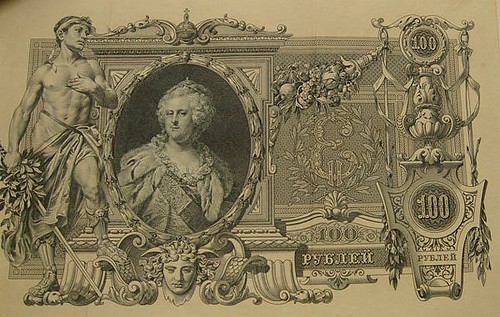
This 100 roubles Russian note pre-dates the Russian Revolution and commemorates the ruler Catherine the Great. The image establishes her legend as a great monarch.
To read the complete article, see: The Intricate Art of the Banknote (www.moneycompare.com.au/blog/the-intricate-art-of-the-banknote.php)
FEATURED WEB SITE: SMALL DOLLARS
This week's Featured Web site is on United States Small Size Dollar Coins and Related Items. Below is an image comparing the size of the Eisenhower and Susan B. Anthony Dollar coins. I learned about the site on the September 30 blog of Susan Headley, the About.com Guide to Coins. She writes:
Every once in a while, I come across a coin related site that is just so well-done and fascinating that I am eager to share it with everyone I talk to. SmallDollars.com is one of those sites! Its entire focus is on the smaller U.S. One Dollar coins of the past 30 years, specifically the Susan B. Anthony Dollar, the Sacagawea Dollar, and the ever popular Presidential Dollars. Coverage on the site includes such fascinating topics as:
- What are Full-Talon Anthony Dollars?
- Anthony Dollar Counterfeits
- Experimental Rinse Sacagawea Dollars
- Sacagawea Dollar VIP Strikes
This is just the tip of the iceberg! If small-module U.S. dollar coins interest you, you could spend hours at this fascinating site
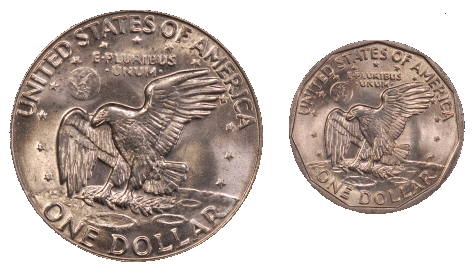
www.smalldollars.com
